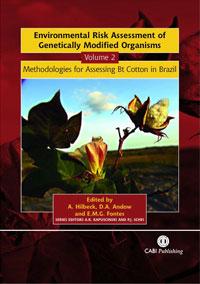
Hilbeck, A., Andow, D.A. and Fontes, E.M.G. (eds) (2006) Environmental Risk Assessment of Genetically Modified Organisms Volume 2: Methodologies for Assessing Bt Cotton in Brazil. CABI Publishing, Wallingford, UK.
"This volume is the second in the series arising out of the IOBC’s GMO Guidelines Project – Development of International Biosafety Testing Methodologies for Transgenic Plants, using the proposed introduction of Bt cotton as a case study. The very knowledgeable author group has written 13 chapters comprehensively covering these methods. In addition to an excellent summary of the cotton situation in Brazil and of the details of the GM cotton proposed for introduction (the now widely used Cry1Ac and Cry1Ac/2Ab cottons), this volume covers assessment of gene flow risks, risks of evolved resistance by insect pests, impacts on non-target pests, pollinators, predators and soil organisms using a Problem Formulation and Options Assessment methodology."
Review by Derek Russell (2007) in Experimental Agriculture 43(2): 265
download full review (PDF)Reviewed in Japanese Society of Applied Entomology and Zoology (2007) Vol. 42, No. 2: 160-161 (in Japanese)

Hilbeck, A. and Andow, D.A. (eds) (2004) Environmental Risk Assessment of Genetically Modified Organisms Volume 1: A Case Study of Bt Maize in Kenya. CABI Publishing, Wallingford, UK.
"The Kenya Bt-maize risk assessment case study prepared by a formidable group of >50 scientists under the editorship of Andow and Hilbeck, is thorough, rigorous, objective, and transparent."
"The third chapter, by Nelson et al., is a Problem formulation and options assessment (PFOA) for Kenya Bt-maize. This is a very informative chapter, particularly for those not familiar with risk assessment procedures."
"The fourth chapter, concerning Bt-maize transgene locus structure and expression, by Andow et al., is excellent. It provides a good and candid discussion, relevant to Kenya, of transgene design, locus structure, expression, and transmission and lists a number of important, including problematic, findings (e.g., available Bt-maize events are likely ineffective against Busseola fusca, one of the two most important stemborers in Kenya).
The fifth chapter, by Birch et al., is a thorough analysis of potential effects and their likely pathways on nontarget organisms. Particularly noteworthy of this chapter is a series of testable hypotheses (and questions) that are presented related to the potential hazards of Bt-maize identified by the authors."
Review by Julio Bernal in Environmental Entomology (2006) 35 (4): 1139-1140
download review (PDF)"The chapters use a refreshingly transparent approach in which the guts of scientific inquiry are visible and limits to discovery are openly described. Overall, the volume is very well written, packed with accessible information, and aptly models a transparent mode of the risk assessment process. The book is multifaceted, and includes a variety of insights not found in other treatments of GMO risk assessment. It sets the stage for a new standard of risk assessment, in which the methods, quality of evidence, and barriers to discovery are discussed openly. Such a conscious treatment of scientific process puts another nail in the coffin for using the term 'scientifically based' for risk assessments that clearly do not meet the kinds of standards described in this volume."
Review by Deborah K. Letourneau (2004) in Environmental Biosafety Research 3: 233-235.
download review (PDF)"The detailed accounts of technical subjects such as transgene locus structure and expression will undoubtedly mean that the book will be used as a review of the state of current knowledge.
The stated aim of the book to provide a comprehensive, transparent and scientific account of the process of risk assessment for environmental and agricultural impacts is also more than adequately fulfilled. It will be a valuable text for post-graduate students, professional scientists (including those designing future generations of GM plants) and policy makers within public and private sectors."Review by Emma L. Tilston (2006) in Agriculture, Ecosystems and Environment. 113 (1-4): 402-403
Review by Derek Russell (2005) in Experimental Agriculture 41(3): 385-386
download review (PDF)